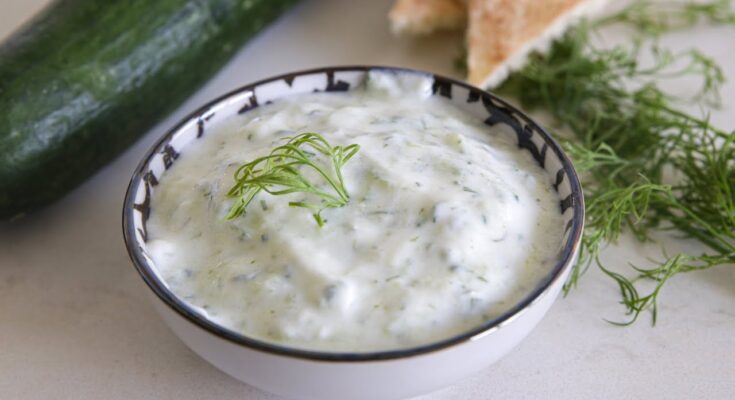Tzatziki Recipe: Tzatziki is a refreshing, creamy dip that has become a staple of Mediterranean and Middle Eastern cuisine. Originating from Greece, it’s known for its cooling flavors, combining tangy yogurt with fresh cucumber, garlic, and herbs. Whether you’re planning a summer barbecue, making gyros, or just looking for a healthy dip, tzatziki is a crowd-pleaser. Best of all, it’s super easy to make at home with just a few simple ingredients!
In this guide, we’ll walk you through each step of making authentic tzatziki, ensuring that your version is just as good—if not better—than what you’d find at a Greek taverna.
What Is Tzatziki?
Tzatziki is a yogurt-based dip or sauce traditionally served in Greek cuisine. It boasts a light, refreshing flavor from the combination of creamy yogurt, cucumber, garlic, olive oil, and fresh herbs. What makes tzatziki special is its versatility—it’s perfect as a dip for vegetables, a sauce for grilled meats, or even a dressing for wraps.
Ingredients for Authentic Tzatziki
Fresh Ingredients List
- Greek Yogurt (2 cups): Full-fat yogurt makes the dip rich and creamy.
- Cucumber (1 large): Use seedless cucumber for the best texture.
- Garlic (2-3 cloves): Adds a sharp, zesty bite.
- Olive Oil (2 tbsp): A touch of olive oil enhances flavor and texture.
- Lemon Juice (1 tbsp): Balances the richness of the yogurt.
- Fresh Dill (2 tbsp): Dill is the traditional herb, though mint is also used.
- Salt and Pepper (to taste): Brings out the flavors of the ingredients.
Optional Add-Ins and Variations
- Parsley: Adds extra freshness if you prefer a more herbaceous taste.
- More Garlic: Increase the garlic for a punchier tzatziki.
- Vegan Option: Swap Greek yogurt with coconut or almond-based yogurt.
Equipment You’ll Need
- Mixing Bowl
- Grater
- Cheesecloth or Strainer
- Whisk
Step-by-Step Tzatziki Recipe
Step 1: Preparing the Cucumber
Start by grating the cucumber. After grating, place it in a cheesecloth or strainer and squeeze out as much water as possible. Removing excess water is essential to keep the tzatziki from becoming watery.
Step 2: Mince the Garlic
Finely mince the garlic cloves. To avoid any bitter taste, you can crush the garlic with a pinch of salt, releasing its oils and mellowing the flavor.
Step 3: Combine Ingredients in a Bowl
In a mixing bowl, add the Greek yogurt, grated cucumber, minced garlic, and olive oil. Stir everything until well combined.
Step 4: Add Fresh Dill and Seasoning
Chop the fresh dill and mix it into the bowl. Add salt and pepper to taste, ensuring all the flavors are balanced.
Step 5: Adjusting Consistency and Taste
If the dip is too thick, add a splash of lemon juice or a bit more olive oil. Taste the mixture and adjust seasoning if needed. Let it rest for at least 30 minutes in the fridge for the flavors to meld.
Tips for the Best Tzatziki
- Use Full-Fat Greek Yogurt: It creates a thicker, creamier dip.
- Chill Before Serving: Tzatziki tastes better when cold, as the flavors develop over time.
- Avoid Over-Salting Early: Wait until all ingredients are mixed before adjusting salt.
How to Store Tzatziki
Store tzatziki in an airtight container in the fridge. It will stay fresh for 3 to 4 days. If you notice any separation, give it a quick stir before serving.
Ways to Serve Tzatziki
Classic Dishes to Pair Tzatziki With
- Gyros and pita wraps
- Falafel
- Grilled meats like lamb or chicken
Unique Ways to Use Tzatziki
- As a dressing for salads
- A spread for sandwiches or burgers
- A dip for roasted vegetables or crackers
Health Benefits of Tzatziki
Tzatziki is a healthy dip choice! It’s low in calories and high in protein, especially if you use Greek yogurt. Additionally, the probiotics in yogurt aid digestion, making it a great option for gut health.
Common Mistakes to Avoid
- Not Squeezing the Cucumber Enough: This leads to watery tzatziki.
- Adding Too Much Garlic: A little goes a long way, so balance it well.
- Skipping the Rest Time: Allowing the dip to rest enhances flavor.
FAQs about Tzatziki Recipe
1. What is Tzatziki?
Tzatziki is a creamy Greek sauce or dip made with yogurt, cucumber, garlic, olive oil, and fresh herbs like dill or mint. It’s often served with pita bread, grilled meats, or as a topping for gyros.
2. What kind of yogurt is best for tzatziki?
Greek yogurt is ideal due to its thick texture and rich taste. If using regular yogurt, you can strain it to remove excess water for a creamier consistency.
3. How long does homemade tzatziki last?
Stored in an airtight container in the refrigerator, tzatziki can last 3 to 4 days. For the best taste, avoid leaving it at room temperature for extended periods.
4. Can I make tzatziki without dill?
Yes, dill is traditional, but you can substitute it with mint, parsley, or even leave it out if preferred. Each herb gives a slightly different flavor profile.
5. How do I keep my tzatziki from getting watery?
To prevent a watery dip, make sure to squeeze out the excess moisture from the cucumber after grating. You can use a cheesecloth or press it with a paper towel.
6. Is tzatziki healthy?
Yes! Tzatziki is low in calories, high in protein, and contains probiotics from yogurt, making it a healthy addition to meals.
7. What can I serve with tzatziki?
Tzatziki pairs well with pita bread, vegetables, grilled chicken, lamb, falafel, or as a spread on sandwiches and wraps.
8. Can I make tzatziki vegan?
Absolutely! Use plant-based yogurt, such as almond or coconut yogurt, for a vegan version. Adjust the seasoning to taste, as plant-based yogurts can differ slightly in flavor.
Conclusion
Making tzatziki at home is easy and rewarding. With just a handful of ingredients and a few simple steps, you can whip up a flavorful, creamy dip that complements a wide range of dishes. Whether you’re serving it with pita or using it as a dressing, tzatziki is guaranteed to elevate your meals. Give it a try—you won’t be disappointed!
References
For further reading and to validate the information provided in this Tzatziki recipe, here are some reputable sources:
- Serious Eats – A trusted site offering detailed insights into traditional and modern Tzatziki variations.
Visit Serious Eats - The Mediterranean Dish – Learn more about the origins and preparation techniques of Tzatziki straight from a Mediterranean-focused food blog.
Explore The Mediterranean Dish - AllRecipes – Browse additional Tzatziki recipes and tips from a large community of home cooks and professional chefs.
Check out AllRecipes - BBC Good Food – Dive into expertly crafted Tzatziki recipes and serving ideas for every occasion.
Browse BBC Good Food
These references provide authentic insights and different recipe variations to enhance your culinary experience.



